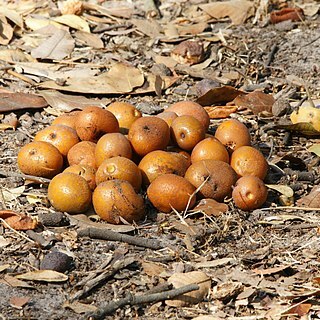A tree that grows up to 12-20 m tall. The trunk is clean. The bark is rough and fire resistant. The young branches are hairy. The leaves are simple and oblong. They are 4-11 cm long by 2-5 cm wide. They narrow towards the base. The upper surfac e is shiny dark green and the lower surface is dull and covered with felt. The veins are conspicuous and run straight to the edge of the leaf. The flower buds occur in sprays at the ends of the branches. The flowers are pale green and have a strong sweet scent. The fruit are 2.5-4 cm long. They are olive green covered with rough grey spots. They become yellowish-red when ripe. The flesh of the fruit clings to the kernel. The fruit are edible. There are 2 subspecies.
Leaf-lamina up to 8·5 x 5·5 or 10 x 4 cm., narrowly or broadly oblong-elliptic, apex rounded or emarginate, very rarely subacute, base usually subcordate, rarely subacute, lower surface usually yellowish; petiole 0·5–1 cm. long; stipules up to 2 x 0·5 cm., papery, caducous.
Tree, up to 12 m high. Leaf lamina discolorous, elliptic, apex rounded. Flowers 4-6 mm in diameter, in compact heads. Fruit oval to round, up to 50 x 35 mm, russet-yellow, greyish scaly and pitted. Flowers light purple to cream.
Inflorescence terminal and axillary, up to 15 x 15 cm.; inflorescence-axes and outside of flower usually (in our area) fulvous-or ferruginous-tomentose, sometimes whitish-tomentose.
Bark grey-black, rough, deeply and closely rectangularly fissured.
Stamens 8; filaments 0·2–0·3 cm. long; staminodes 0·05 cm. long.
Crown dense, rounded, umbrella-shaped, casting heavy shade.
Small or medium-sized evergreen tree 3–20 m. tall.
Flowers white tinged with pink, fragrant.
Drupe broadly ellipsoid, up to 4 x 3 cm.
Sepals and petals 0·25 cm. long.
A savannah tree, to 25 ft. high
Receptacle-tube 0·45 cm. long.
Leaves pale green beneath
Style 0·4 cm. long.
Black fissured bark
Petals white.


